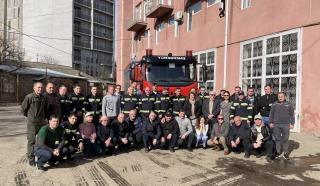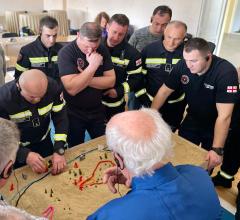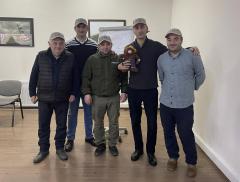Improving wildfire response through interagency cooperation

WASHINGTON, DC—More than 30 natural resource and emergency managers from the Republic of Georgia met in Tbilisi, the capital city, to exchange wildfire suppression best practices and learn how the incident command system could bolster their effectiveness. International Programs sent a cadre of U.S.-based fire and emergency management experts to facilitate a two-day training with Georgian Emergency Management Services, the Agency for Protected Areas and the National Forestry Agency.
The challenge of interagency coordination is prevalent around the world, even in the United States. In post-Soviet countries, a lack of interagency coordination tends to be a core barrier to efficient response in large-scale disasters. Participants noted this issue occurred in the Borjomi-Kharagauli Fire in the summer of 2022.
That’s why the two-day training was held—to showcase how a culture of interagency cooperation could improve the efficiency and effectiveness of Georgia’s emergency response. During the training, participants engaged in hands-on table exercises and role-playing of emergency management scenarios and, throughout, indicated they saw the importance of working together. They noted that Agency for Protected Areas and National Forestry Agency, as forest land managers, would often be the first responders to an incident. Emergency Management Services would arrive later; the agencies would then need to work together to determine next steps.
Importantly, there was a broad Georgian government presence at the training. In addition to the aforementioned agencies, there were also delegates from the Ministry of Environmental Protection and Agriculture and a member of the Georgian Parliamentary Committee on the Environment.
Following the conclusion of the training in Tbilisi, the Forest Service International Programs team spent three days with APA and NFA officials responsible for managing the Borjomi-Kharagauli National Park. This engagement supported the development and refinement of a fire management plan, which had not existed in an operational capacity before.
Working collaboratively on the FMP with the Forest Service team allowed the park land managers to clearly identify what would and would not work, given their limited financial and human resources. These discussions helped to inform paths forward related to roles and responsibilities, wildfire prevention and education, wildfire preparedness and response, and interagency coordination.
The sessions in Tbilisi and Borjomi-Kharagauli were funded by USAID’s Bureau for Humanitarian Assistance and guided and implemented by the US Forest Service International Programs. With over a decade’s worth of experience in the Republic of Georgia, the Forest Service continues to support their work related to natural resource and emergency management. Sharing experience and ideas with our partners informs future engagements with Georgia and strengthens our programming in the United States.


